Comprehensive Analysis of Costs, Revenue, and Costing at Tesco
VerifiedAdded on 2020/10/22
|19
|3975
|120
Report
AI Summary
This report delves into the costing and revenue systems employed by Tesco, a major UK-based retailer. It explores the role of costing systems, including internal reporting, and analyzes various costing methods like absorption and marginal costing, alongside responsibility, profit, investment, and cost centers. The report examines cost classifications, inventory valuation using FIFO, and the behavior of costs. It then addresses cost apportionment, overhead absorption rates, and the analysis of budget deviations, comparing budgeted and actual costs. Furthermore, it covers the use of costing systems in decision-making, considering factors affecting unit costs and long-term and short-term decisions. The report provides a comprehensive overview of Tesco's financial management practices, including detailed cost sheets and variance analyses.
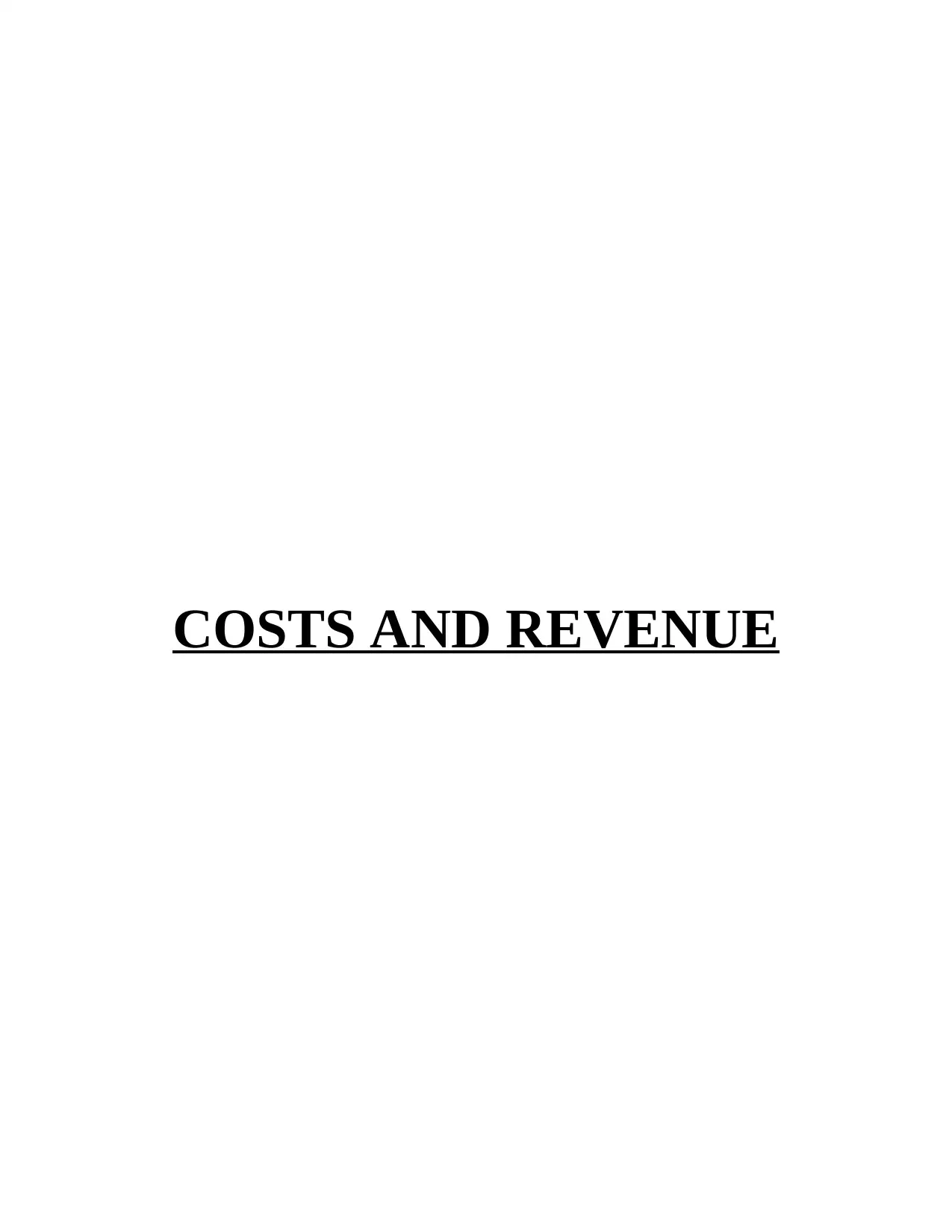
COSTS AND REVENUE
Paraphrase This Document
Need a fresh take? Get an instant paraphrase of this document with our AI Paraphraser
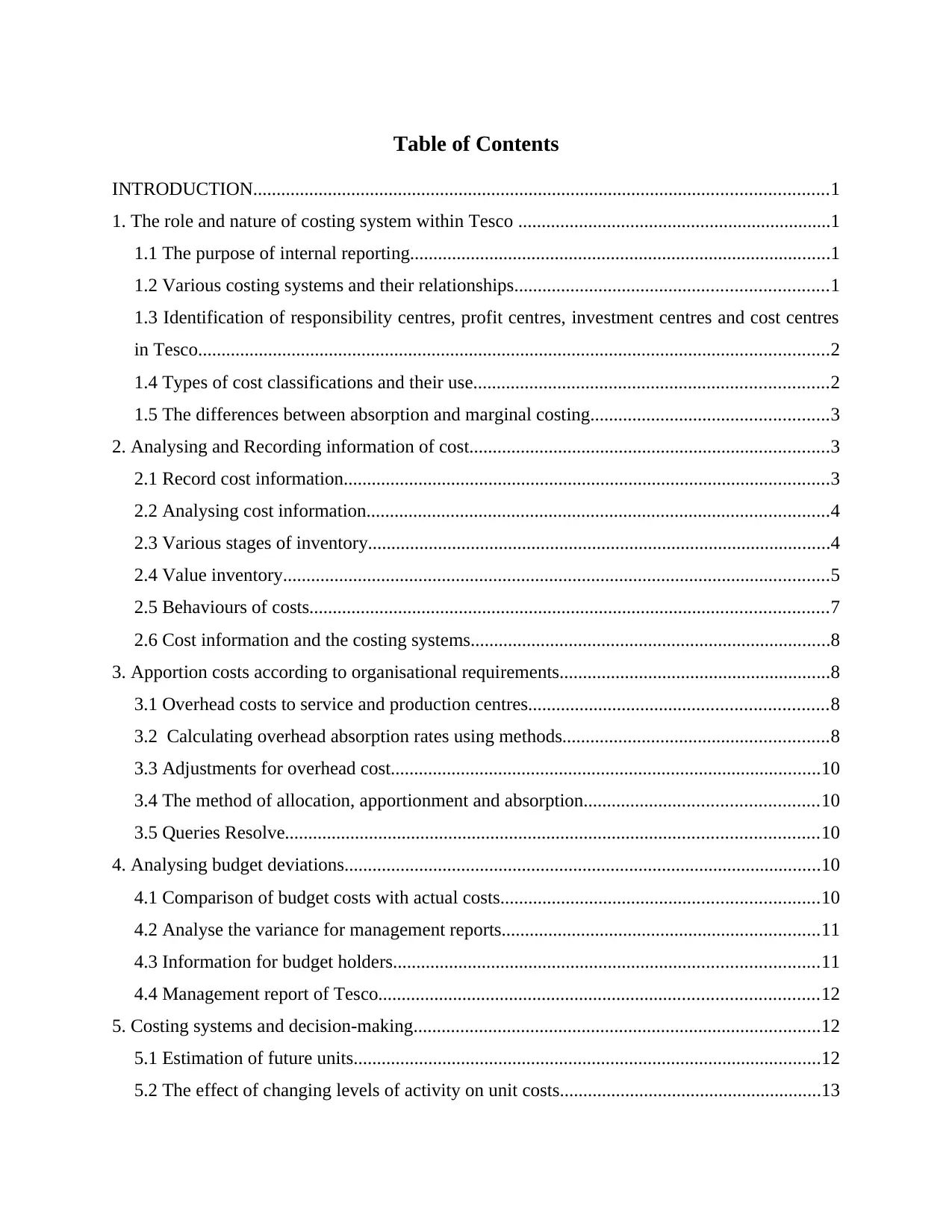
Table of Contents
INTRODUCTION...........................................................................................................................1
1. The role and nature of costing system within Tesco ...................................................................1
1.1 The purpose of internal reporting..........................................................................................1
1.2 Various costing systems and their relationships...................................................................1
1.3 Identification of responsibility centres, profit centres, investment centres and cost centres
in Tesco.......................................................................................................................................2
1.4 Types of cost classifications and their use............................................................................2
1.5 The differences between absorption and marginal costing...................................................3
2. Analysing and Recording information of cost.............................................................................3
2.1 Record cost information........................................................................................................3
2.2 Analysing cost information...................................................................................................4
2.3 Various stages of inventory...................................................................................................4
2.4 Value inventory.....................................................................................................................5
2.5 Behaviours of costs...............................................................................................................7
2.6 Cost information and the costing systems.............................................................................8
3. Apportion costs according to organisational requirements..........................................................8
3.1 Overhead costs to service and production centres................................................................8
3.2 Calculating overhead absorption rates using methods.........................................................8
3.3 Adjustments for overhead cost............................................................................................10
3.4 The method of allocation, apportionment and absorption..................................................10
3.5 Queries Resolve..................................................................................................................10
4. Analysing budget deviations......................................................................................................10
4.1 Comparison of budget costs with actual costs....................................................................10
4.2 Analyse the variance for management reports....................................................................11
4.3 Information for budget holders...........................................................................................11
4.4 Management report of Tesco..............................................................................................12
5. Costing systems and decision-making.......................................................................................12
5.1 Estimation of future units....................................................................................................12
5.2 The effect of changing levels of activity on unit costs........................................................13
INTRODUCTION...........................................................................................................................1
1. The role and nature of costing system within Tesco ...................................................................1
1.1 The purpose of internal reporting..........................................................................................1
1.2 Various costing systems and their relationships...................................................................1
1.3 Identification of responsibility centres, profit centres, investment centres and cost centres
in Tesco.......................................................................................................................................2
1.4 Types of cost classifications and their use............................................................................2
1.5 The differences between absorption and marginal costing...................................................3
2. Analysing and Recording information of cost.............................................................................3
2.1 Record cost information........................................................................................................3
2.2 Analysing cost information...................................................................................................4
2.3 Various stages of inventory...................................................................................................4
2.4 Value inventory.....................................................................................................................5
2.5 Behaviours of costs...............................................................................................................7
2.6 Cost information and the costing systems.............................................................................8
3. Apportion costs according to organisational requirements..........................................................8
3.1 Overhead costs to service and production centres................................................................8
3.2 Calculating overhead absorption rates using methods.........................................................8
3.3 Adjustments for overhead cost............................................................................................10
3.4 The method of allocation, apportionment and absorption..................................................10
3.5 Queries Resolve..................................................................................................................10
4. Analysing budget deviations......................................................................................................10
4.1 Comparison of budget costs with actual costs....................................................................10
4.2 Analyse the variance for management reports....................................................................11
4.3 Information for budget holders...........................................................................................11
4.4 Management report of Tesco..............................................................................................12
5. Costing systems and decision-making.......................................................................................12
5.1 Estimation of future units....................................................................................................12
5.2 The effect of changing levels of activity on unit costs........................................................13
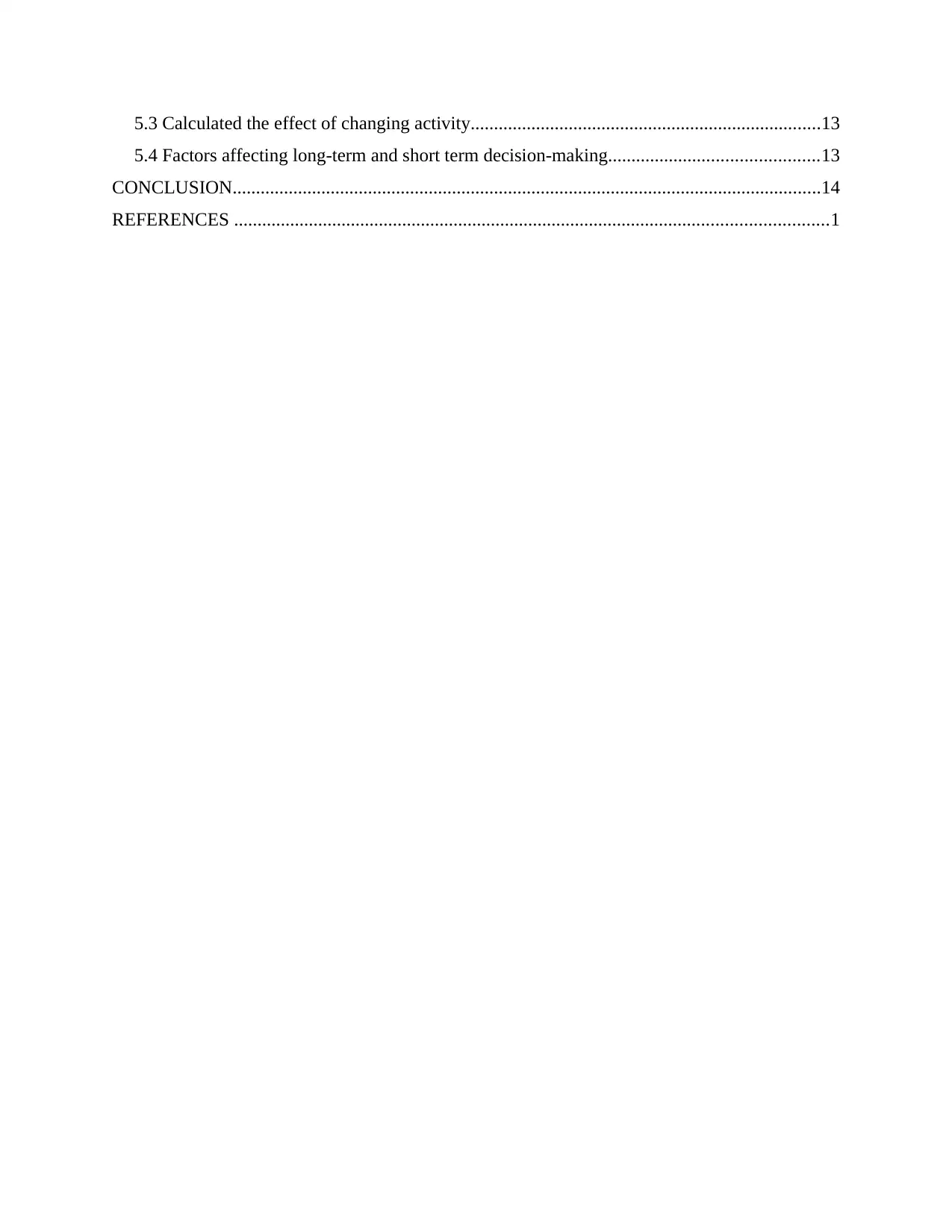
5.3 Calculated the effect of changing activity...........................................................................13
5.4 Factors affecting long-term and short term decision-making.............................................13
CONCLUSION..............................................................................................................................14
REFERENCES ...............................................................................................................................1
5.4 Factors affecting long-term and short term decision-making.............................................13
CONCLUSION..............................................................................................................................14
REFERENCES ...............................................................................................................................1
⊘ This is a preview!⊘
Do you want full access?
Subscribe today to unlock all pages.

Trusted by 1+ million students worldwide
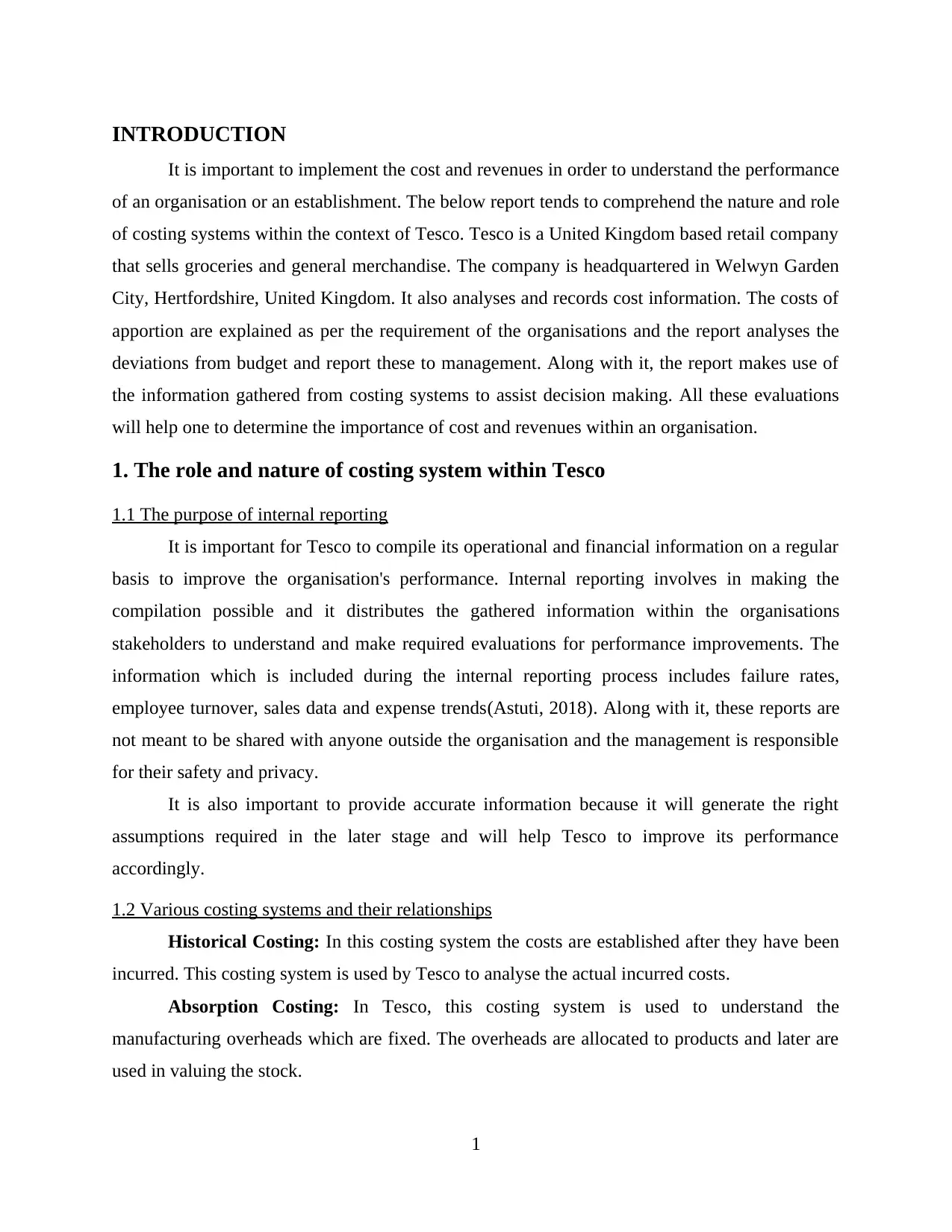
INTRODUCTION
It is important to implement the cost and revenues in order to understand the performance
of an organisation or an establishment. The below report tends to comprehend the nature and role
of costing systems within the context of Tesco. Tesco is a United Kingdom based retail company
that sells groceries and general merchandise. The company is headquartered in Welwyn Garden
City, Hertfordshire, United Kingdom. It also analyses and records cost information. The costs of
apportion are explained as per the requirement of the organisations and the report analyses the
deviations from budget and report these to management. Along with it, the report makes use of
the information gathered from costing systems to assist decision making. All these evaluations
will help one to determine the importance of cost and revenues within an organisation.
1. The role and nature of costing system within Tesco
1.1 The purpose of internal reporting
It is important for Tesco to compile its operational and financial information on a regular
basis to improve the organisation's performance. Internal reporting involves in making the
compilation possible and it distributes the gathered information within the organisations
stakeholders to understand and make required evaluations for performance improvements. The
information which is included during the internal reporting process includes failure rates,
employee turnover, sales data and expense trends(Astuti, 2018). Along with it, these reports are
not meant to be shared with anyone outside the organisation and the management is responsible
for their safety and privacy.
It is also important to provide accurate information because it will generate the right
assumptions required in the later stage and will help Tesco to improve its performance
accordingly.
1.2 Various costing systems and their relationships
Historical Costing: In this costing system the costs are established after they have been
incurred. This costing system is used by Tesco to analyse the actual incurred costs.
Absorption Costing: In Tesco, this costing system is used to understand the
manufacturing overheads which are fixed. The overheads are allocated to products and later are
used in valuing the stock.
1
It is important to implement the cost and revenues in order to understand the performance
of an organisation or an establishment. The below report tends to comprehend the nature and role
of costing systems within the context of Tesco. Tesco is a United Kingdom based retail company
that sells groceries and general merchandise. The company is headquartered in Welwyn Garden
City, Hertfordshire, United Kingdom. It also analyses and records cost information. The costs of
apportion are explained as per the requirement of the organisations and the report analyses the
deviations from budget and report these to management. Along with it, the report makes use of
the information gathered from costing systems to assist decision making. All these evaluations
will help one to determine the importance of cost and revenues within an organisation.
1. The role and nature of costing system within Tesco
1.1 The purpose of internal reporting
It is important for Tesco to compile its operational and financial information on a regular
basis to improve the organisation's performance. Internal reporting involves in making the
compilation possible and it distributes the gathered information within the organisations
stakeholders to understand and make required evaluations for performance improvements. The
information which is included during the internal reporting process includes failure rates,
employee turnover, sales data and expense trends(Astuti, 2018). Along with it, these reports are
not meant to be shared with anyone outside the organisation and the management is responsible
for their safety and privacy.
It is also important to provide accurate information because it will generate the right
assumptions required in the later stage and will help Tesco to improve its performance
accordingly.
1.2 Various costing systems and their relationships
Historical Costing: In this costing system the costs are established after they have been
incurred. This costing system is used by Tesco to analyse the actual incurred costs.
Absorption Costing: In Tesco, this costing system is used to understand the
manufacturing overheads which are fixed. The overheads are allocated to products and later are
used in valuing the stock.
1
Paraphrase This Document
Need a fresh take? Get an instant paraphrase of this document with our AI Paraphraser
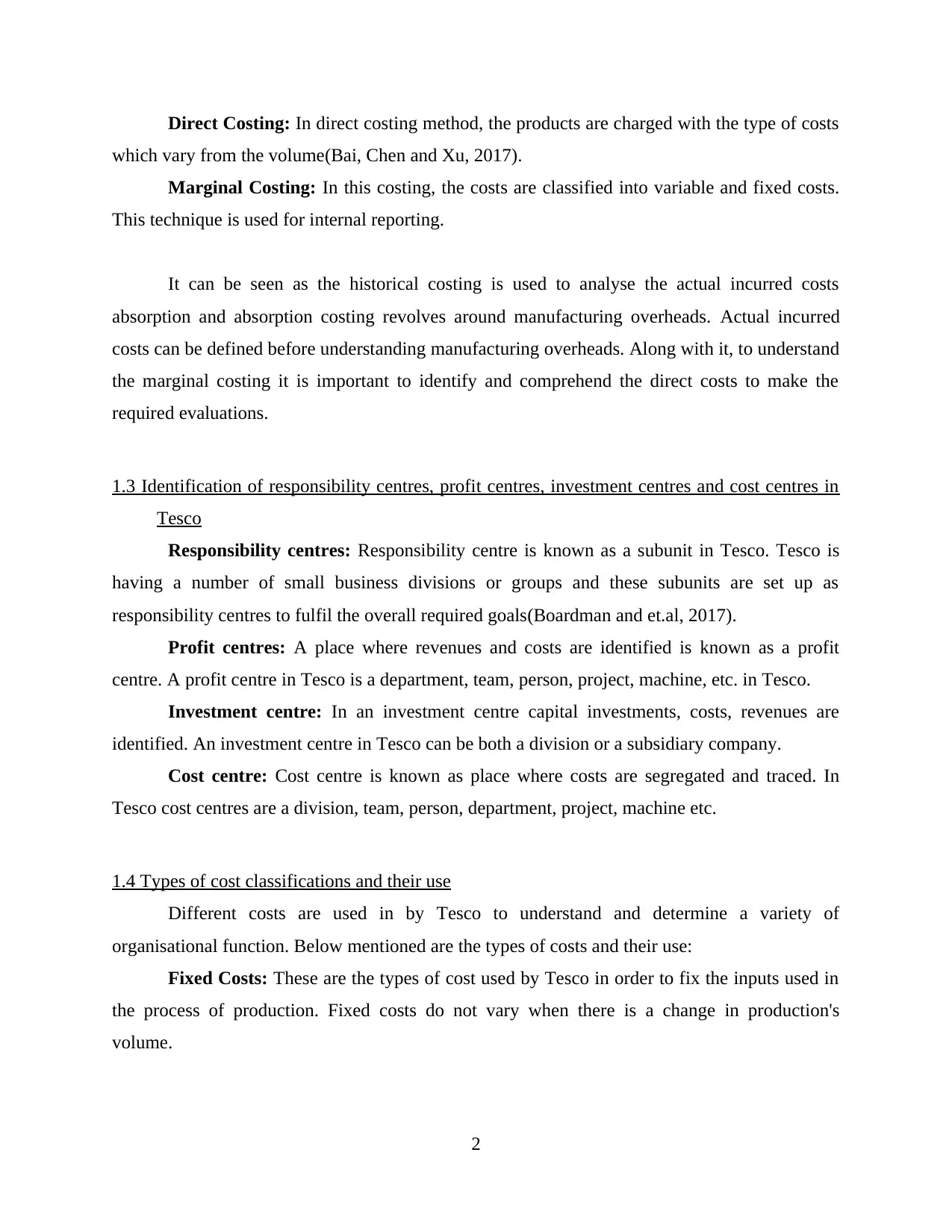
Direct Costing: In direct costing method, the products are charged with the type of costs
which vary from the volume(Bai, Chen and Xu, 2017).
Marginal Costing: In this costing, the costs are classified into variable and fixed costs.
This technique is used for internal reporting.
It can be seen as the historical costing is used to analyse the actual incurred costs
absorption and absorption costing revolves around manufacturing overheads. Actual incurred
costs can be defined before understanding manufacturing overheads. Along with it, to understand
the marginal costing it is important to identify and comprehend the direct costs to make the
required evaluations.
1.3 Identification of responsibility centres, profit centres, investment centres and cost centres in
Tesco
Responsibility centres: Responsibility centre is known as a subunit in Tesco. Tesco is
having a number of small business divisions or groups and these subunits are set up as
responsibility centres to fulfil the overall required goals(Boardman and et.al, 2017).
Profit centres: A place where revenues and costs are identified is known as a profit
centre. A profit centre in Tesco is a department, team, person, project, machine, etc. in Tesco.
Investment centre: In an investment centre capital investments, costs, revenues are
identified. An investment centre in Tesco can be both a division or a subsidiary company.
Cost centre: Cost centre is known as place where costs are segregated and traced. In
Tesco cost centres are a division, team, person, department, project, machine etc.
1.4 Types of cost classifications and their use
Different costs are used in by Tesco to understand and determine a variety of
organisational function. Below mentioned are the types of costs and their use:
Fixed Costs: These are the types of cost used by Tesco in order to fix the inputs used in
the process of production. Fixed costs do not vary when there is a change in production's
volume.
2
which vary from the volume(Bai, Chen and Xu, 2017).
Marginal Costing: In this costing, the costs are classified into variable and fixed costs.
This technique is used for internal reporting.
It can be seen as the historical costing is used to analyse the actual incurred costs
absorption and absorption costing revolves around manufacturing overheads. Actual incurred
costs can be defined before understanding manufacturing overheads. Along with it, to understand
the marginal costing it is important to identify and comprehend the direct costs to make the
required evaluations.
1.3 Identification of responsibility centres, profit centres, investment centres and cost centres in
Tesco
Responsibility centres: Responsibility centre is known as a subunit in Tesco. Tesco is
having a number of small business divisions or groups and these subunits are set up as
responsibility centres to fulfil the overall required goals(Boardman and et.al, 2017).
Profit centres: A place where revenues and costs are identified is known as a profit
centre. A profit centre in Tesco is a department, team, person, project, machine, etc. in Tesco.
Investment centre: In an investment centre capital investments, costs, revenues are
identified. An investment centre in Tesco can be both a division or a subsidiary company.
Cost centre: Cost centre is known as place where costs are segregated and traced. In
Tesco cost centres are a division, team, person, department, project, machine etc.
1.4 Types of cost classifications and their use
Different costs are used in by Tesco to understand and determine a variety of
organisational function. Below mentioned are the types of costs and their use:
Fixed Costs: These are the types of cost used by Tesco in order to fix the inputs used in
the process of production. Fixed costs do not vary when there is a change in production's
volume.
2
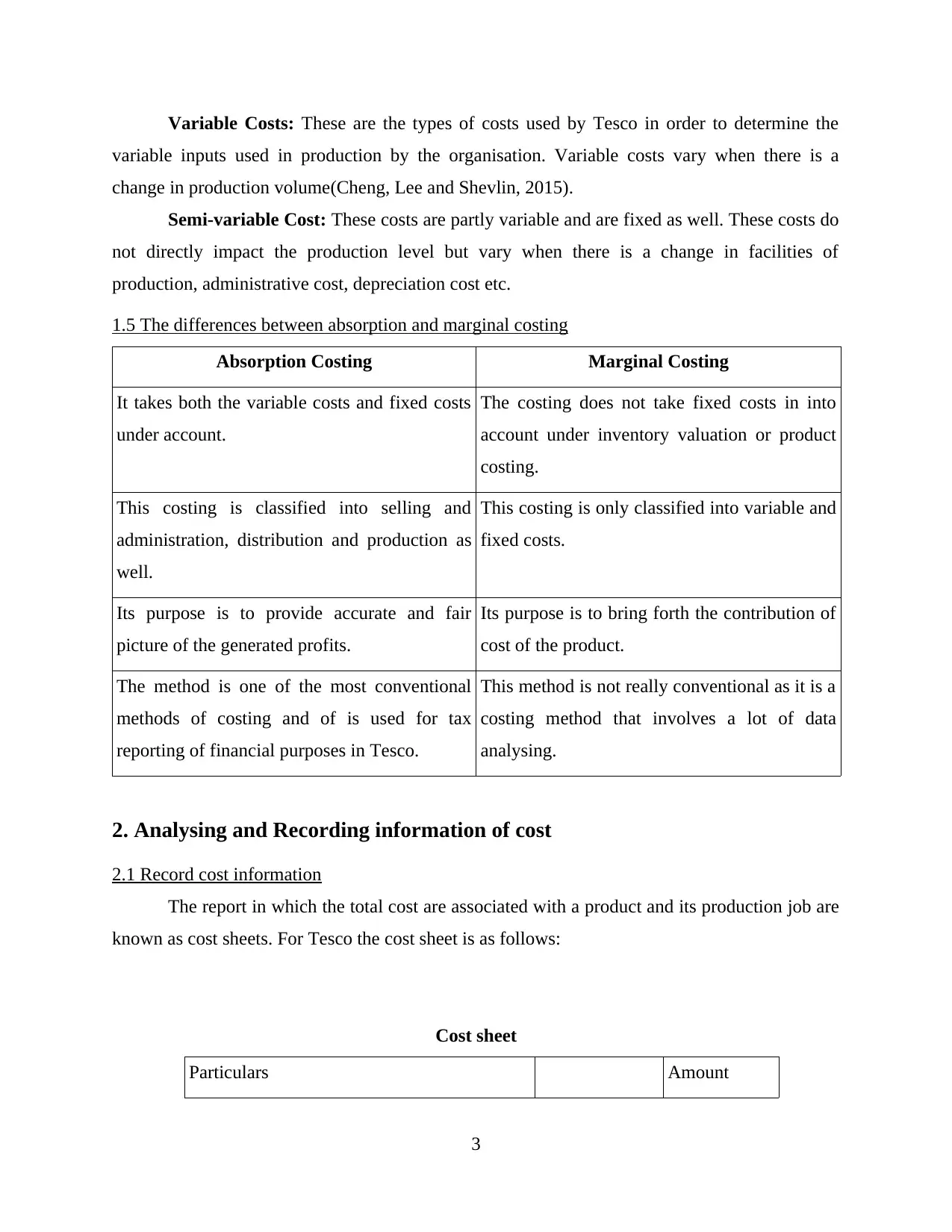
Variable Costs: These are the types of costs used by Tesco in order to determine the
variable inputs used in production by the organisation. Variable costs vary when there is a
change in production volume(Cheng, Lee and Shevlin, 2015).
Semi-variable Cost: These costs are partly variable and are fixed as well. These costs do
not directly impact the production level but vary when there is a change in facilities of
production, administrative cost, depreciation cost etc.
1.5 The differences between absorption and marginal costing
Absorption Costing Marginal Costing
It takes both the variable costs and fixed costs
under account.
The costing does not take fixed costs in into
account under inventory valuation or product
costing.
This costing is classified into selling and
administration, distribution and production as
well.
This costing is only classified into variable and
fixed costs.
Its purpose is to provide accurate and fair
picture of the generated profits.
Its purpose is to bring forth the contribution of
cost of the product.
The method is one of the most conventional
methods of costing and of is used for tax
reporting of financial purposes in Tesco.
This method is not really conventional as it is a
costing method that involves a lot of data
analysing.
2. Analysing and Recording information of cost
2.1 Record cost information
The report in which the total cost are associated with a product and its production job are
known as cost sheets. For Tesco the cost sheet is as follows:
Cost sheet
Particulars Amount
3
variable inputs used in production by the organisation. Variable costs vary when there is a
change in production volume(Cheng, Lee and Shevlin, 2015).
Semi-variable Cost: These costs are partly variable and are fixed as well. These costs do
not directly impact the production level but vary when there is a change in facilities of
production, administrative cost, depreciation cost etc.
1.5 The differences between absorption and marginal costing
Absorption Costing Marginal Costing
It takes both the variable costs and fixed costs
under account.
The costing does not take fixed costs in into
account under inventory valuation or product
costing.
This costing is classified into selling and
administration, distribution and production as
well.
This costing is only classified into variable and
fixed costs.
Its purpose is to provide accurate and fair
picture of the generated profits.
Its purpose is to bring forth the contribution of
cost of the product.
The method is one of the most conventional
methods of costing and of is used for tax
reporting of financial purposes in Tesco.
This method is not really conventional as it is a
costing method that involves a lot of data
analysing.
2. Analysing and Recording information of cost
2.1 Record cost information
The report in which the total cost are associated with a product and its production job are
known as cost sheets. For Tesco the cost sheet is as follows:
Cost sheet
Particulars Amount
3
⊘ This is a preview!⊘
Do you want full access?
Subscribe today to unlock all pages.

Trusted by 1+ million students worldwide
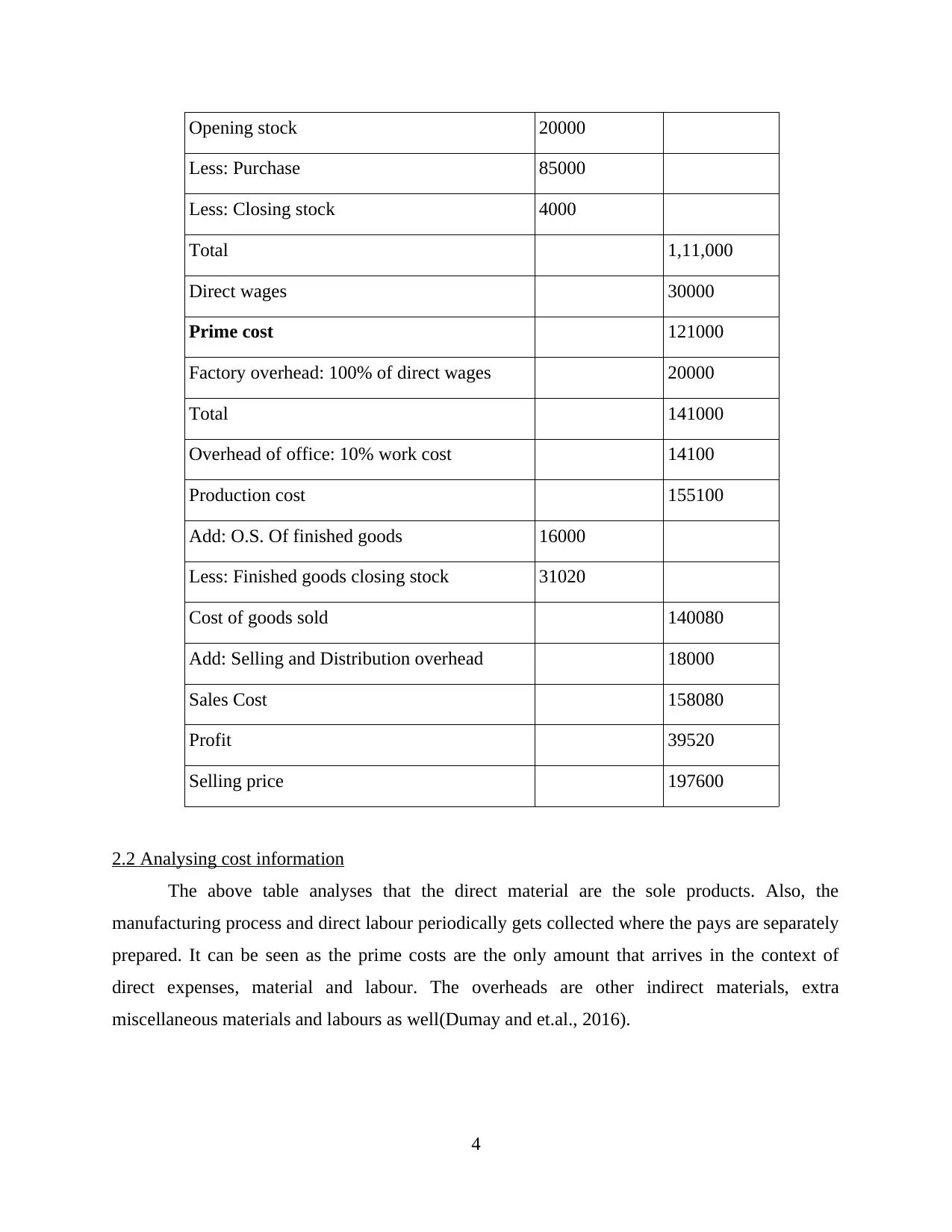
Opening stock 20000
Less: Purchase 85000
Less: Closing stock 4000
Total 1,11,000
Direct wages 30000
Prime cost 121000
Factory overhead: 100% of direct wages 20000
Total 141000
Overhead of office: 10% work cost 14100
Production cost 155100
Add: O.S. Of finished goods 16000
Less: Finished goods closing stock 31020
Cost of goods sold 140080
Add: Selling and Distribution overhead 18000
Sales Cost 158080
Profit 39520
Selling price 197600
2.2 Analysing cost information
The above table analyses that the direct material are the sole products. Also, the
manufacturing process and direct labour periodically gets collected where the pays are separately
prepared. It can be seen as the prime costs are the only amount that arrives in the context of
direct expenses, material and labour. The overheads are other indirect materials, extra
miscellaneous materials and labours as well(Dumay and et.al., 2016).
4
Less: Purchase 85000
Less: Closing stock 4000
Total 1,11,000
Direct wages 30000
Prime cost 121000
Factory overhead: 100% of direct wages 20000
Total 141000
Overhead of office: 10% work cost 14100
Production cost 155100
Add: O.S. Of finished goods 16000
Less: Finished goods closing stock 31020
Cost of goods sold 140080
Add: Selling and Distribution overhead 18000
Sales Cost 158080
Profit 39520
Selling price 197600
2.2 Analysing cost information
The above table analyses that the direct material are the sole products. Also, the
manufacturing process and direct labour periodically gets collected where the pays are separately
prepared. It can be seen as the prime costs are the only amount that arrives in the context of
direct expenses, material and labour. The overheads are other indirect materials, extra
miscellaneous materials and labours as well(Dumay and et.al., 2016).
4
Paraphrase This Document
Need a fresh take? Get an instant paraphrase of this document with our AI Paraphraser
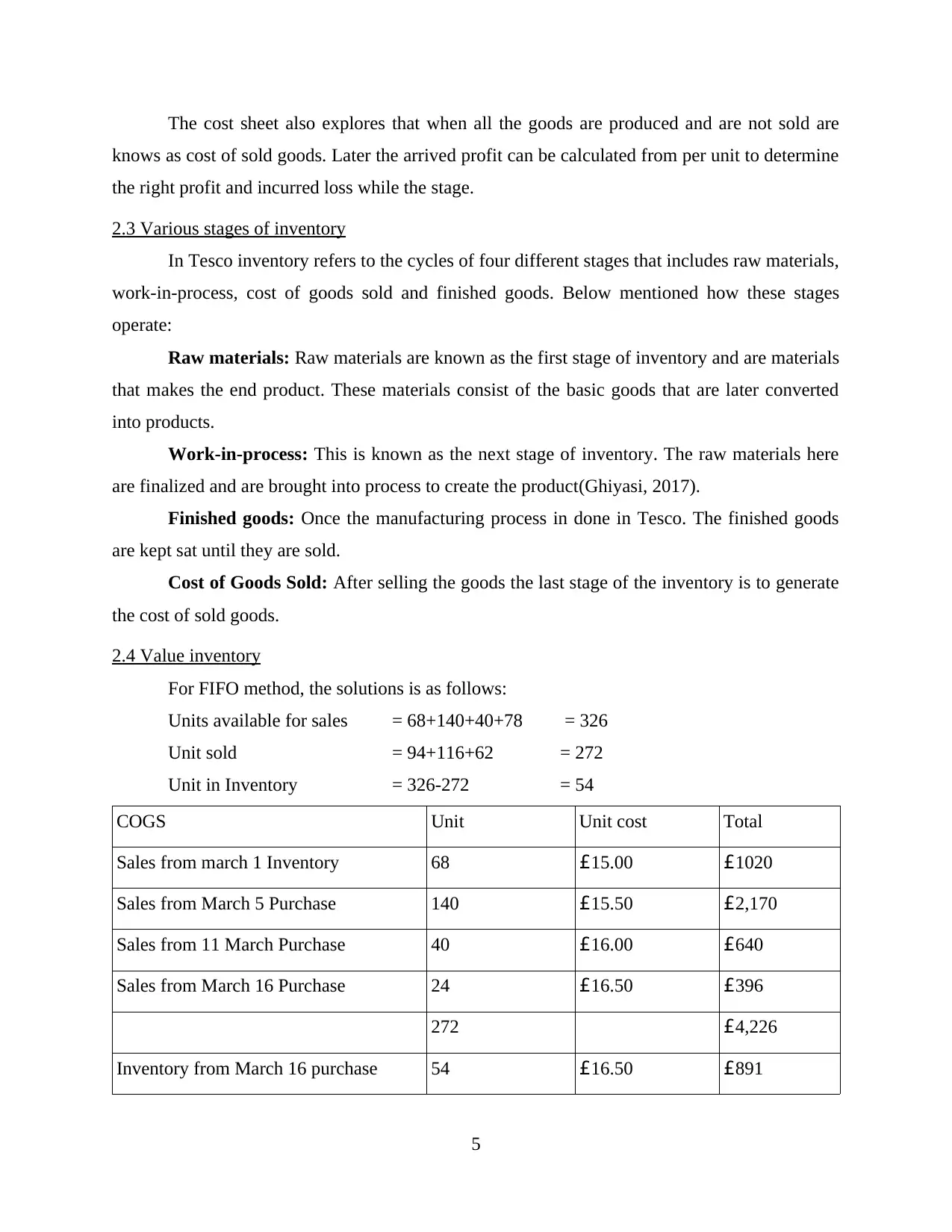
The cost sheet also explores that when all the goods are produced and are not sold are
knows as cost of sold goods. Later the arrived profit can be calculated from per unit to determine
the right profit and incurred loss while the stage.
2.3 Various stages of inventory
In Tesco inventory refers to the cycles of four different stages that includes raw materials,
work-in-process, cost of goods sold and finished goods. Below mentioned how these stages
operate:
Raw materials: Raw materials are known as the first stage of inventory and are materials
that makes the end product. These materials consist of the basic goods that are later converted
into products.
Work-in-process: This is known as the next stage of inventory. The raw materials here
are finalized and are brought into process to create the product(Ghiyasi, 2017).
Finished goods: Once the manufacturing process in done in Tesco. The finished goods
are kept sat until they are sold.
Cost of Goods Sold: After selling the goods the last stage of the inventory is to generate
the cost of sold goods.
2.4 Value inventory
For FIFO method, the solutions is as follows:
Units available for sales = 68+140+40+78 = 326
Unit sold = 94+116+62 = 272
Unit in Inventory = 326-272 = 54
COGS Unit Unit cost Total
Sales from march 1 Inventory 68 £15.00 £1020
Sales from March 5 Purchase 140 £15.50 £2,170
Sales from 11 March Purchase 40 £16.00 £640
Sales from March 16 Purchase 24 £16.50 £396
272 £4,226
Inventory from March 16 purchase 54 £16.50 £891
5
knows as cost of sold goods. Later the arrived profit can be calculated from per unit to determine
the right profit and incurred loss while the stage.
2.3 Various stages of inventory
In Tesco inventory refers to the cycles of four different stages that includes raw materials,
work-in-process, cost of goods sold and finished goods. Below mentioned how these stages
operate:
Raw materials: Raw materials are known as the first stage of inventory and are materials
that makes the end product. These materials consist of the basic goods that are later converted
into products.
Work-in-process: This is known as the next stage of inventory. The raw materials here
are finalized and are brought into process to create the product(Ghiyasi, 2017).
Finished goods: Once the manufacturing process in done in Tesco. The finished goods
are kept sat until they are sold.
Cost of Goods Sold: After selling the goods the last stage of the inventory is to generate
the cost of sold goods.
2.4 Value inventory
For FIFO method, the solutions is as follows:
Units available for sales = 68+140+40+78 = 326
Unit sold = 94+116+62 = 272
Unit in Inventory = 326-272 = 54
COGS Unit Unit cost Total
Sales from march 1 Inventory 68 £15.00 £1020
Sales from March 5 Purchase 140 £15.50 £2,170
Sales from 11 March Purchase 40 £16.00 £640
Sales from March 16 Purchase 24 £16.50 £396
272 £4,226
Inventory from March 16 purchase 54 £16.50 £891
5
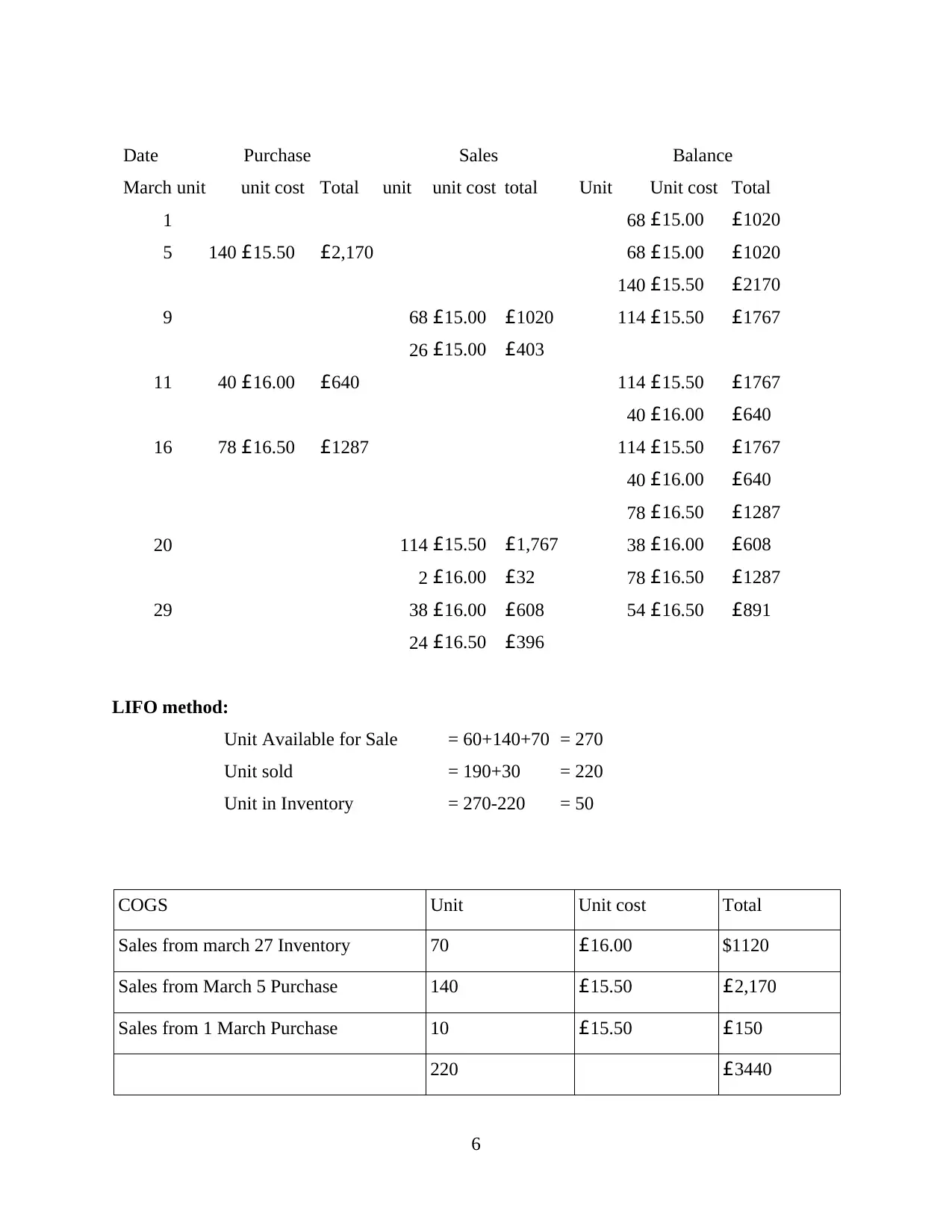
Date Purchase Sales Balance
March unit unit cost Total unit unit cost total Unit Unit cost Total
1 68 £15.00 £1020
5 140 £15.50 £2,170 68 £15.00 £1020
140 £15.50 £2170
9 68 £15.00 £1020 114 £15.50 £1767
26 £15.00 £403
11 40 £16.00 £640 114 £15.50 £1767
40 £16.00 £640
16 78 £16.50 £1287 114 £15.50 £1767
40 £16.00 £640
78 £16.50 £1287
20 114 £15.50 £1,767 38 £16.00 £608
2 £16.00 £32 78 £16.50 £1287
29 38 £16.00 £608 54 £16.50 £891
24 £16.50 £396
LIFO method:
Unit Available for Sale = 60+140+70 = 270
Unit sold = 190+30 = 220
Unit in Inventory = 270-220 = 50
COGS Unit Unit cost Total
Sales from march 27 Inventory 70 £16.00 $1120
Sales from March 5 Purchase 140 £15.50 £2,170
Sales from 1 March Purchase 10 £15.50 £150
220 £3440
6
March unit unit cost Total unit unit cost total Unit Unit cost Total
1 68 £15.00 £1020
5 140 £15.50 £2,170 68 £15.00 £1020
140 £15.50 £2170
9 68 £15.00 £1020 114 £15.50 £1767
26 £15.00 £403
11 40 £16.00 £640 114 £15.50 £1767
40 £16.00 £640
16 78 £16.50 £1287 114 £15.50 £1767
40 £16.00 £640
78 £16.50 £1287
20 114 £15.50 £1,767 38 £16.00 £608
2 £16.00 £32 78 £16.50 £1287
29 38 £16.00 £608 54 £16.50 £891
24 £16.50 £396
LIFO method:
Unit Available for Sale = 60+140+70 = 270
Unit sold = 190+30 = 220
Unit in Inventory = 270-220 = 50
COGS Unit Unit cost Total
Sales from march 27 Inventory 70 £16.00 $1120
Sales from March 5 Purchase 140 £15.50 £2,170
Sales from 1 March Purchase 10 £15.50 £150
220 £3440
6
⊘ This is a preview!⊘
Do you want full access?
Subscribe today to unlock all pages.

Trusted by 1+ million students worldwide
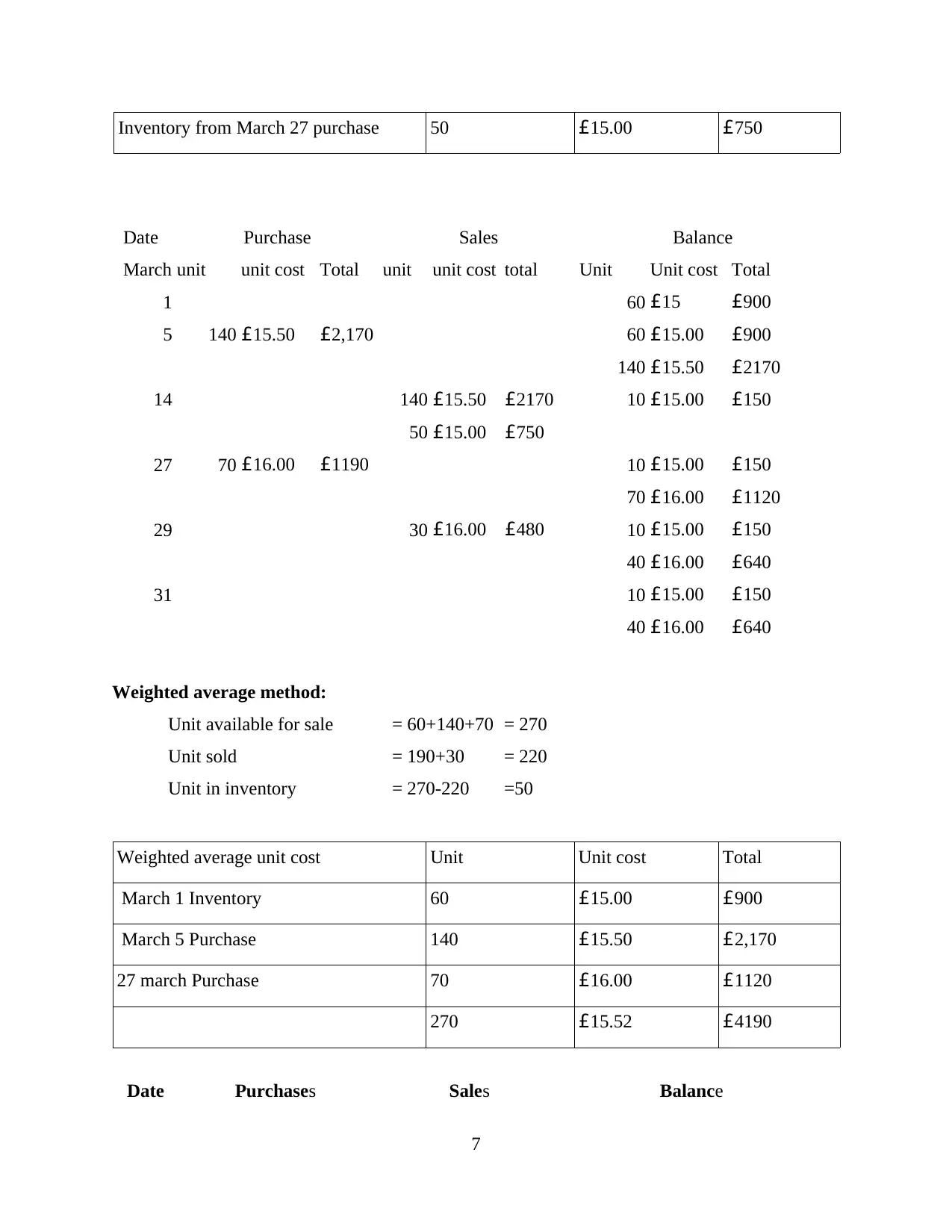
Inventory from March 27 purchase 50 £15.00 £750
Date Purchase Sales Balance
March unit unit cost Total unit unit cost total Unit Unit cost Total
1 60 £15 £900
5 140 £15.50 £2,170 60 £15.00 £900
140 £15.50 £2170
14 140 £15.50 £2170 10 £15.00 £150
50 £15.00 £750
27 70 £16.00 £1190 10 £15.00 £150
70 £16.00 £1120
29 30 £16.00 £480 10 £15.00 £150
40 £16.00 £640
31 10 £15.00 £150
40 £16.00 £640
Weighted average method:
Unit available for sale = 60+140+70 = 270
Unit sold = 190+30 = 220
Unit in inventory = 270-220 =50
Weighted average unit cost Unit Unit cost Total
March 1 Inventory 60 £15.00 £900
March 5 Purchase 140 £15.50 £2,170
27 march Purchase 70 £16.00 £1120
270 £15.52 £4190
Date Purchases Sales Balance
7
Date Purchase Sales Balance
March unit unit cost Total unit unit cost total Unit Unit cost Total
1 60 £15 £900
5 140 £15.50 £2,170 60 £15.00 £900
140 £15.50 £2170
14 140 £15.50 £2170 10 £15.00 £150
50 £15.00 £750
27 70 £16.00 £1190 10 £15.00 £150
70 £16.00 £1120
29 30 £16.00 £480 10 £15.00 £150
40 £16.00 £640
31 10 £15.00 £150
40 £16.00 £640
Weighted average method:
Unit available for sale = 60+140+70 = 270
Unit sold = 190+30 = 220
Unit in inventory = 270-220 =50
Weighted average unit cost Unit Unit cost Total
March 1 Inventory 60 £15.00 £900
March 5 Purchase 140 £15.50 £2,170
27 march Purchase 70 £16.00 £1120
270 £15.52 £4190
Date Purchases Sales Balance
7
Paraphrase This Document
Need a fresh take? Get an instant paraphrase of this document with our AI Paraphraser
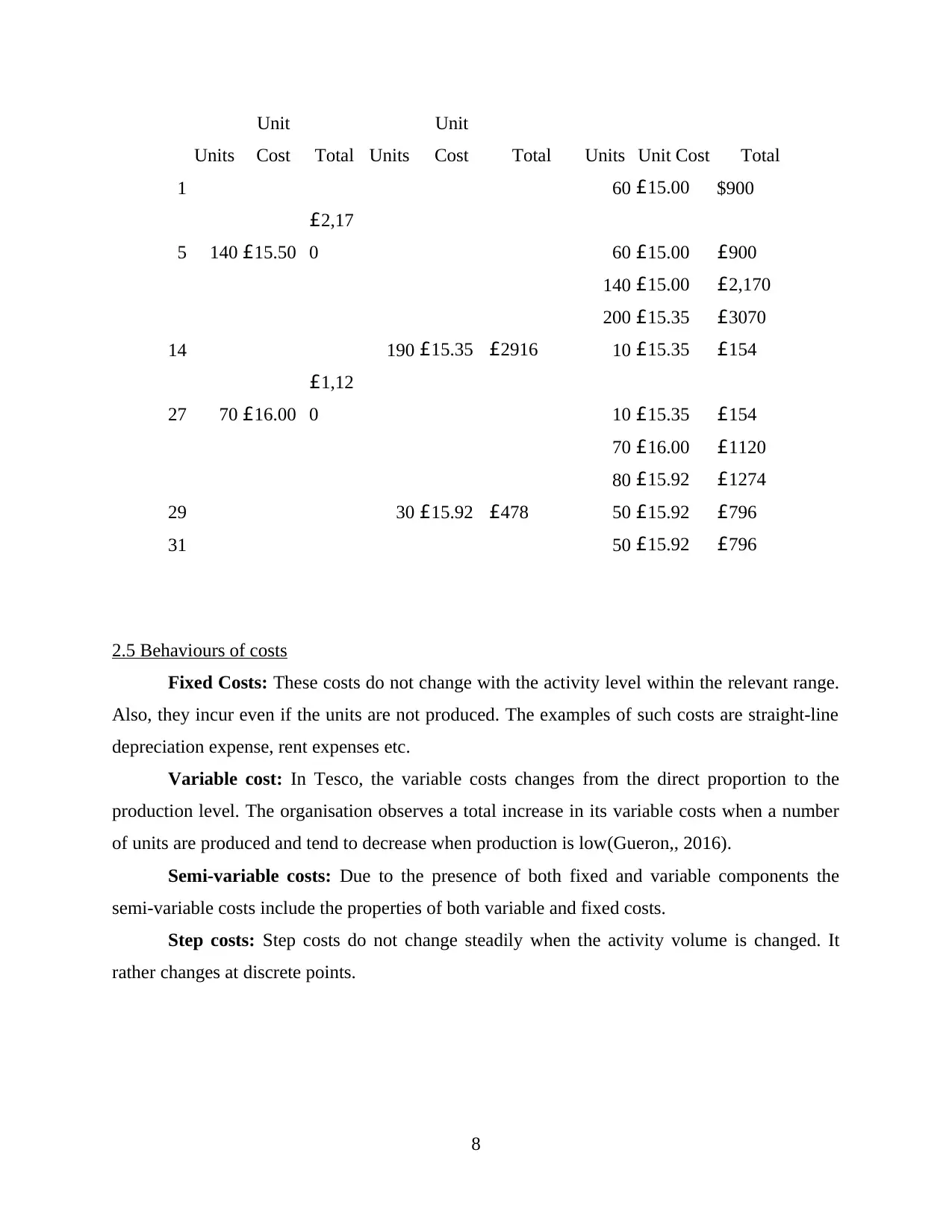
Units
Unit
Cost Total Units
Unit
Cost Total Units Unit Cost Total
1 60 £15.00 $900
5 140 £15.50
£2,17
0 60 £15.00 £900
140 £15.00 £2,170
200 £15.35 £3070
14 190 £15.35 £2916 10 £15.35 £154
27 70 £16.00
£1,12
0 10 £15.35 £154
70 £16.00 £1120
80 £15.92 £1274
29 30 £15.92 £478 50 £15.92 £796
31 50 £15.92 £796
2.5 Behaviours of costs
Fixed Costs: These costs do not change with the activity level within the relevant range.
Also, they incur even if the units are not produced. The examples of such costs are straight-line
depreciation expense, rent expenses etc.
Variable cost: In Tesco, the variable costs changes from the direct proportion to the
production level. The organisation observes a total increase in its variable costs when a number
of units are produced and tend to decrease when production is low(Gueron,, 2016).
Semi-variable costs: Due to the presence of both fixed and variable components the
semi-variable costs include the properties of both variable and fixed costs.
Step costs: Step costs do not change steadily when the activity volume is changed. It
rather changes at discrete points.
8
Unit
Cost Total Units
Unit
Cost Total Units Unit Cost Total
1 60 £15.00 $900
5 140 £15.50
£2,17
0 60 £15.00 £900
140 £15.00 £2,170
200 £15.35 £3070
14 190 £15.35 £2916 10 £15.35 £154
27 70 £16.00
£1,12
0 10 £15.35 £154
70 £16.00 £1120
80 £15.92 £1274
29 30 £15.92 £478 50 £15.92 £796
31 50 £15.92 £796
2.5 Behaviours of costs
Fixed Costs: These costs do not change with the activity level within the relevant range.
Also, they incur even if the units are not produced. The examples of such costs are straight-line
depreciation expense, rent expenses etc.
Variable cost: In Tesco, the variable costs changes from the direct proportion to the
production level. The organisation observes a total increase in its variable costs when a number
of units are produced and tend to decrease when production is low(Gueron,, 2016).
Semi-variable costs: Due to the presence of both fixed and variable components the
semi-variable costs include the properties of both variable and fixed costs.
Step costs: Step costs do not change steadily when the activity volume is changed. It
rather changes at discrete points.
8
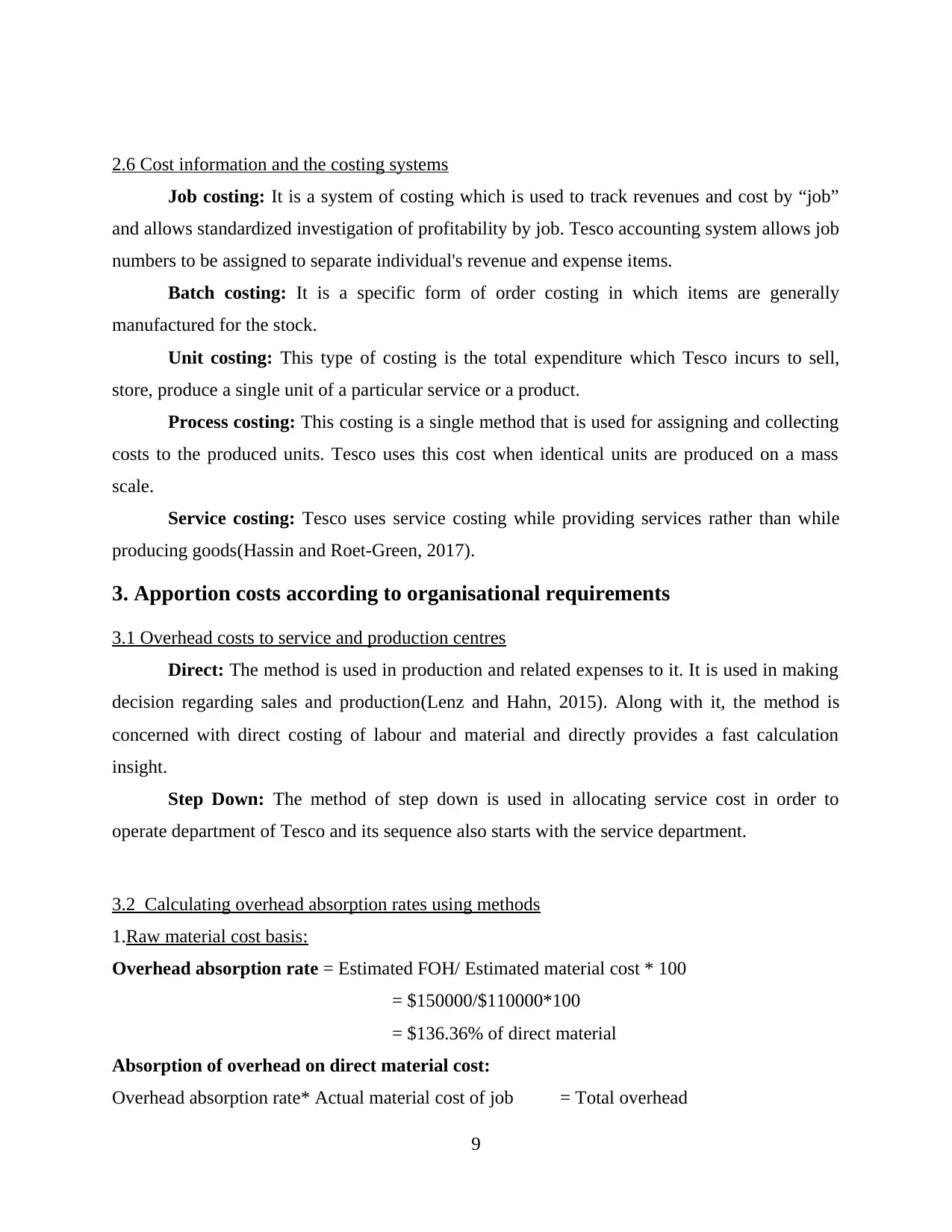
2.6 Cost information and the costing systems
Job costing: It is a system of costing which is used to track revenues and cost by “job”
and allows standardized investigation of profitability by job. Tesco accounting system allows job
numbers to be assigned to separate individual's revenue and expense items.
Batch costing: It is a specific form of order costing in which items are generally
manufactured for the stock.
Unit costing: This type of costing is the total expenditure which Tesco incurs to sell,
store, produce a single unit of a particular service or a product.
Process costing: This costing is a single method that is used for assigning and collecting
costs to the produced units. Tesco uses this cost when identical units are produced on a mass
scale.
Service costing: Tesco uses service costing while providing services rather than while
producing goods(Hassin and Roet-Green, 2017).
3. Apportion costs according to organisational requirements
3.1 Overhead costs to service and production centres
Direct: The method is used in production and related expenses to it. It is used in making
decision regarding sales and production(Lenz and Hahn, 2015). Along with it, the method is
concerned with direct costing of labour and material and directly provides a fast calculation
insight.
Step Down: The method of step down is used in allocating service cost in order to
operate department of Tesco and its sequence also starts with the service department.
3.2 Calculating overhead absorption rates using methods
1.Raw material cost basis:
Overhead absorption rate = Estimated FOH/ Estimated material cost * 100
= $150000/$110000*100
= $136.36% of direct material
Absorption of overhead on direct material cost:
Overhead absorption rate* Actual material cost of job = Total overhead
9
Job costing: It is a system of costing which is used to track revenues and cost by “job”
and allows standardized investigation of profitability by job. Tesco accounting system allows job
numbers to be assigned to separate individual's revenue and expense items.
Batch costing: It is a specific form of order costing in which items are generally
manufactured for the stock.
Unit costing: This type of costing is the total expenditure which Tesco incurs to sell,
store, produce a single unit of a particular service or a product.
Process costing: This costing is a single method that is used for assigning and collecting
costs to the produced units. Tesco uses this cost when identical units are produced on a mass
scale.
Service costing: Tesco uses service costing while providing services rather than while
producing goods(Hassin and Roet-Green, 2017).
3. Apportion costs according to organisational requirements
3.1 Overhead costs to service and production centres
Direct: The method is used in production and related expenses to it. It is used in making
decision regarding sales and production(Lenz and Hahn, 2015). Along with it, the method is
concerned with direct costing of labour and material and directly provides a fast calculation
insight.
Step Down: The method of step down is used in allocating service cost in order to
operate department of Tesco and its sequence also starts with the service department.
3.2 Calculating overhead absorption rates using methods
1.Raw material cost basis:
Overhead absorption rate = Estimated FOH/ Estimated material cost * 100
= $150000/$110000*100
= $136.36% of direct material
Absorption of overhead on direct material cost:
Overhead absorption rate* Actual material cost of job = Total overhead
9
⊘ This is a preview!⊘
Do you want full access?
Subscribe today to unlock all pages.

Trusted by 1+ million students worldwide
1 out of 19
Related Documents
Your All-in-One AI-Powered Toolkit for Academic Success.
+13062052269
info@desklib.com
Available 24*7 on WhatsApp / Email
![[object Object]](/_next/static/media/star-bottom.7253800d.svg)
Unlock your academic potential
Copyright © 2020–2025 A2Z Services. All Rights Reserved. Developed and managed by ZUCOL.





